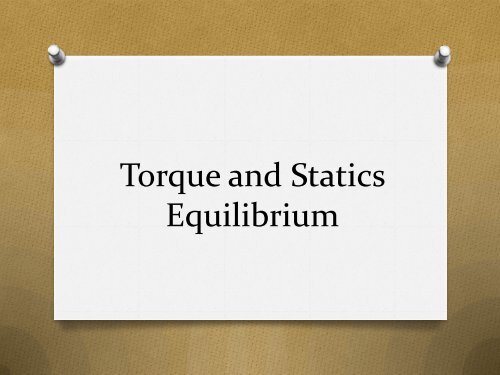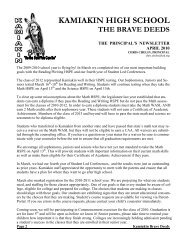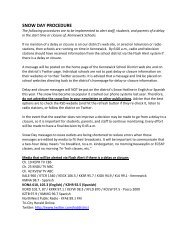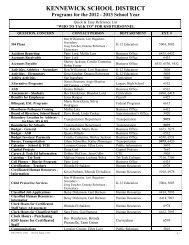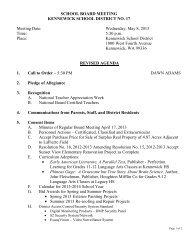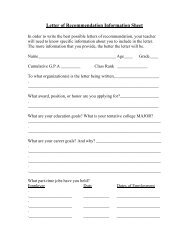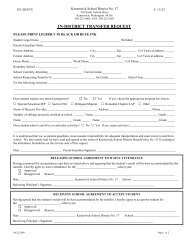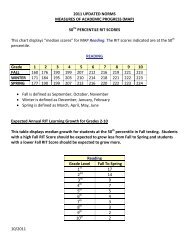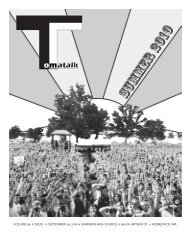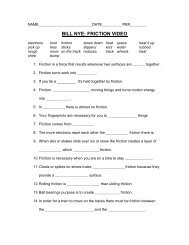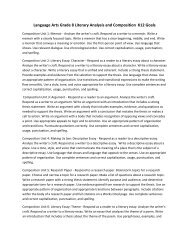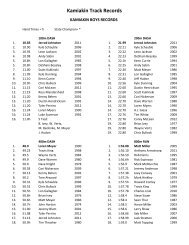Torque and Statics Equilibrium
Torque and Statics Equilibrium
Torque and Statics Equilibrium
You also want an ePaper? Increase the reach of your titles
YUMPU automatically turns print PDFs into web optimized ePapers that Google loves.
<strong>Torque</strong> <strong>and</strong> <strong>Statics</strong><br />
<strong>Equilibrium</strong>
Objectives<br />
O Students should underst<strong>and</strong> the concept of torque, so<br />
they can:<br />
O Calculate the magnitude <strong>and</strong> direction of the torque<br />
associated with a given force.<br />
O Calculate the torque on a rigid object due to gravity.<br />
O Students should be able to analyze problems in statics,<br />
so they can:<br />
O State the conditions for translational <strong>and</strong> rotational<br />
equilibrium of a rigid object.<br />
O Apply these conditions in analyzing the equilibrium of a<br />
rigid object under the combined influence of a number of<br />
coplanar forces applied at different locations.
8-4: <strong>Torque</strong><br />
O To make an object start rotating, a force is needed; the<br />
position <strong>and</strong> direction of the force matter as well.<br />
O The perpendicular distance from the axis of rotation to<br />
the line along which the force acts is called the lever<br />
arm.<br />
O The torque is defined as:<br />
τ = rF sin θ
O The most efficient direction of force is perpendicular to<br />
a radius from the axis of rotation, <strong>and</strong> the least efficient<br />
direction is parallel to a radius form the axis of rotation.<br />
O <strong>Torque</strong> is additive when force is applied in the same<br />
angular direction, <strong>and</strong> it is subtracted when applied in<br />
the opposite angular direction.<br />
O Counterclockwise torque is, by convention, a positive<br />
quantity, whereas clockwise torque is considered a<br />
negative quantity
Example 8-8: Biceps torque<br />
O The biceps muscle exerts a<br />
vertical force on the lower<br />
arm as shown in figure (a)<br />
<strong>and</strong> (b). For each case,<br />
calculate the torque about the<br />
axis of rotation through the<br />
elbow joint, assuming the<br />
muscle is attached 5 cm from<br />
the elbow as shown.
Exercise B<br />
O Two forces (F B = 20 N <strong>and</strong> F A = 30 N) are applied to a<br />
meter stick which can rotate about its left end. Force F B<br />
is applied perpendicularly at the midpoint. Which force<br />
exerts the greater torque?
Example 8-9: <strong>Torque</strong> on a compound wheel<br />
O Two thin disk-shaped wheels, of radii r A = 30 cm<br />
<strong>and</strong> r B = 50 cm, are attached to each other on an<br />
axle that passes through the center of each, as<br />
shown. Calculate the net torque on this compound<br />
wheel due to the two forces shown, each of<br />
magnitude 50 N.
9-1: The Conditions for <strong>Equilibrium</strong><br />
O An object with forces acting on it, but that is not<br />
moving, is said to be in equilibrium.<br />
O The first condition for equilibrium is that the forces<br />
along each coordinate axis add to zero.<br />
O The second condition of equilibrium is that there be<br />
no torque around any axis; the choice of axis is<br />
arbitrary.
Example 9-1: Straightening teeth<br />
O The wire b<strong>and</strong> shown has a tension F T of 2 N along it. It<br />
therefore exerts forces of 2.0 N on the highlighted tooth<br />
(to which it is attached) in the two directions shown.<br />
Calculate the resultant force on the tooth due to the<br />
wire, F R .
Example 9-2: Ch<strong>and</strong>elier cord tension<br />
O Calculate the tensions F A <strong>and</strong> F B in the two cords<br />
that are connected to the vertical cord supporting<br />
the 200-kg ch<strong>and</strong>elier.
Exercise A<br />
O In Example 9-2, F A has to be greater than the<br />
ch<strong>and</strong>elier’s weight, mg. Why?
Example 9-3: A lever<br />
O The bar shown is being used as a lever to pry up a large<br />
rock. The small rock acts as a fulcrum (pivot point). The<br />
force F P required at the long end of the bar can be quite<br />
a bit smaller than the rock’s weight mg, since it is the<br />
torques that balance in the rotation about the fulcrum.<br />
If, however, the leverage isn’t sufficient, <strong>and</strong> the large<br />
rock isn’t budged, what are two ways to increase the<br />
leverage?
Exercise B<br />
O For simplicity, we wrote the equation in Example 9-3 as<br />
if the lever were perpendicular to the forces. Would the<br />
equation be valid even for a lever at an angle as shown<br />
in the figure.
9-2: Solving <strong>Statics</strong> Problems<br />
1. Choose one object at a time, <strong>and</strong> make a free-body<br />
diagram showing all the forces on it <strong>and</strong> where they<br />
act.<br />
2. Choose a coordinate system <strong>and</strong> resolve forces into<br />
components.<br />
3. Write equilibrium equations for the forces.<br />
4. Choose any axis perpendicular to the plane of the<br />
forces <strong>and</strong> write the torque equilibrium equation. A<br />
clever choice here can simplify the problem<br />
enormously.<br />
5. Solve.
Example 9-4: Balancing a seesaw<br />
O A board of mass M = 2.0 kg serves as a seesaw for two<br />
children. Child A has a mass of 30 kg <strong>and</strong> sits 2.5 m<br />
from the pivot point, P (his center of gravity is 2.5 m<br />
from the pivot). At what distance x from the pivot must<br />
child B, of mass 25 kg, place herself to balance the<br />
seesaw? Assume the board is uniform <strong>and</strong> centered<br />
over the pivot.
Exercise C<br />
O We did not need to use the force equation to solve<br />
Example 9-4 because of our choice of the axis. Use the<br />
force equation to find the force exerted by the pivot.
Example 9-5: Forces on a beam <strong>and</strong> supports<br />
O A uniform 1500-kg beam, 20.0 m long, supports a<br />
15,000-kg printing press 5.0 m from the right support<br />
column. Calculate the force on each of the vertical<br />
support columns.
Example 9-6: Hinged beam <strong>and</strong> cable<br />
O A uniform beam, 2.20 m long with mass m = 25.0 kg, is<br />
mounted by a hinge on a wall as shown. The beam is<br />
held in a horizontal position by a cable that makes an<br />
angle θ = 30° as shown. The beam supports a sign of<br />
mass M = 28.0 kg suspended from its end. Determine<br />
the components of the force F H that the hinge exerts on<br />
the beam, <strong>and</strong> the tension F T in the supporting cable.


